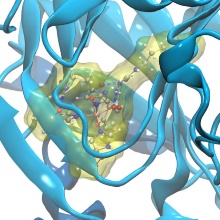QM/MM: an Introduction
My research is based on electronic structure calculations. These are computationally demanding tasks, needing typically days to finish on a modern computer. The QM/MM approach is used to treat complex systems with many atoms. The reaction center is described by quantum mechanics (QM). This allows reliable predictions about the breaking and formation of chemical bonds. The environment is described by a classical force field, by molecular mechanics (MM). While being several orders of magnitude faster than QM, the bond pattern remains fixed. The combination (QM/MM) allows for accurate prediction of reaction energies with reasonable computation times. In electrostatic embedding, the QM density is polarized by the MM charges. QM/MM is especially suited for the simulations of biological systems.
ChemShell
Our method and code development concerning QM/MM is done in the context of the ChemShell code [1]. It combines standalone QM- and MM programs to perform geometry optimizations, or molecular dynamics. The input files are shell scripts, which allows for enormous flexibility in the simulations. ChemShell was written by Paul Sherwood. Working in his group, I had added new methods to the code. For more information, see www.chemshell.org.
However, QM/MM is not just the combination of these two methods. It implies treating systems with many (thousands) degrees of freedom with still relatively time consuming energy evaluations. This requires special techniques for the two most common tasks in computational chemistry: structure optimization and molecular dynamics.
Microiterative QM/MM Geometry Optimization
The effort of geometry optimization increases with the system size. In order to be able to optimize large systems with a QM/MM Energy expression, we use an iterative scheme: The QM system is optimized in standard QM/MM calculations. However, between consecutive QM steps, the MM system is completely optimized using MM calculations. Some care is necessary to use this with electrostatic embedding. We came up with a scheme that converges well, saving up to an order of magnitude in computation time [2].
QM/MM Free-Energy Perturbation
In large systems, typically in all biological systems, the (internal) energy is not appropriate to address chemical questions (in contrast to small chemical systems). Instead, the free energy has to be used. Calculating this quantity requires sampling of the configurational space. Sampling (MD simulations) is in general too expensive for the QM/MM approach with high-level QM methods. To sample at least the contribution of the MM part to the free-entropy change, one can use QM/MM based molecular dynamics free-energy perturbation (QM/MM-FEP, see J. Chem. Phys. 112, 3483 (2000)). In a project with Walter Thiel, I implemented [3] the QM/MM-FEP scheme into ChemShell.
Averaged Reaction Barriers from Snapshots
An alternative to QM/MM-FEP is to perform classical molecular dynamics simulations at the reactant state minimum, use several starting geometries of such a trajectory (snapshots) and average the resulting barriers. The latter are calculated from minimizations and transition state searches based on QM/MM forces. Even with a small set of maybe half a dozen snapshots one obtains a good average of reaction barriers as demonstrated in a few examples [4].
A different method to calculate free energies is umbrella sampling with umbrella integration analysis.
A nice two-page summary of our work on QM/MM methods is available in Frontiers 2006.



